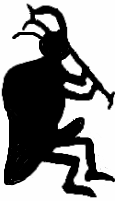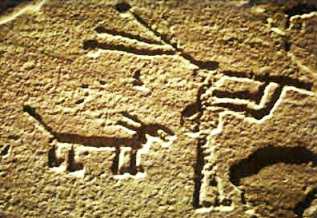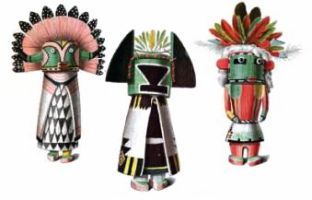Kokopelli
Definition of Kokopelli: What is a Kokopelli? Kokopelli is a legendary supernatural creature that features as a fertility deity in the stories, myths and legends of the different Southwest tribes of Native American Indians, notably the Hopi and the Zuni. Kokopelli is usually depicted as a hunchbacked, dancing flute player and minstrel wearing antlers or horns on his head. In Native American traditions antlers and horns signified spiritual power. Occasionally Kokopelli is also depicted with a large phallus reflecting his role as a fertility spirit and. Kokopelli was believed to be a spirit who brought a sense of security and well-being to the people, assuring their success in hunting, growing crops and in human conception.
Native American Mythology
Mythical Creatures
Monsters and Mythical Creatures List
The Description, Role & Symbolism of Kokopelli
The role of Kokopelli is strongly associated with fertility, music making, dancing and spreading joy. He is also identified as a Trickster disobeying normal rules and conventional behavior. Kokopelli is believed to travel from village to village bringing the change of the season and bringing rain for a successful harvest. The distinguishing features of the Kokopelli and their symbolism are as follows:
- Hunchback: Kokopelli is always depicted as a hunchback creature - The hump on his back represented a sack that he carried which might contain seeds for the harvest, his songs and beautiful rainbows
- Flute: Kokopelli is usually depicted playing a flute - his music was believed to change the winter to spring
- Antlers: Kokopelli is depicted with antlers or horns that signified his spiritual power
- Knobbly Knees: He is sometimes depicted with knobbly knees indicating advancing age and perhaps caused by carrying his heavy sack
- Phallus: He is occasionally depicted with a large phallus representing sexual desire and reflecting his role of fertility spirit

Phallic Kokopelli - Fertility Symbol
Kokopelli - Casanova of the Cliff Dwellers
Kokopelli is an ancient deity and pictures have been found on prehistoric American rock carvings, petroglyphs and pictographs of the Southwest dating back thousands of years. The Kokopelli deity is associated with the Mississippian mound builders culture that flourished in what is now the Midwestern, Eastern, and Southeastern United States from approximately 800 CE to 1500 CE.
The Kokopelli deity is also associated with the Anasazi culture who were builders of the ancient cliff dwellings found in the canyons of the Southwest. From this association Kokopelli has been given the nickname "Casanova of the Cliff Dwellers". This idea continues with the Hopi as in their legends Kokopelli carries unborn children on his back and distributes them to women. For this reason, young unmarried girls often fear him!

Chaco Canyon Kokopelli
Kokopelli the Kachina
The term 'Kachinas' can refer to spirits, dancers and carved dolls. There are many Kachinas that feature in Hopi ceremonies and dances and Kokopelli is the most famous of all. The picture at the top of the page depicts a Kokopelli Kachina drawings made by a Hopi Indian. On top of his head is a warrior feather connecting Kokopelli to survival through war. Among the Hopi, Kachinas are understood to have human like relationships and may marry and have children. The wife of Kokopelli is called Kokopelmana by the Hopi. Kokopelli plays an important role in ceremonies and rituals relating to marriage.

Yei Symbol - The Rainbow Kokopelli
The "Rainbow Kokopelli" is a Yei deity who commands the rainbow, giving beauty and joy to all those in harmony. This derives from the idea that his sack was made of clouds full of rainbows or seeds.

The Kokopelli
- Spirits, deities and creatures that feature in Native Indian Mythology
- The Kokopelli, Culture and Mythology
- Interesting facts and info about the Kokopelli for kids and schools
- American Indian Mythology, Myths and Legends - Kokopellis
- The trickster and culture hero
Kokopelli - Pictures and Videos of Native Americans
Mythical Creatures. Discover the vast selection of pictures which relate to the History and Culture of Native Americans. The pictures show the clothing, War Paint, weapons and decorations of various Native Indian tribes that can be used as a really useful educational history resource for kids and children of all ages. We have included pictures and videos to accompany the main topic of this section - American Indian Mythology and culture. The videos enable fast access to the images, paintings and pictures together with information and many historical facts. All of the articles and pages can be accessed via the Native Indian Tribes Index - a great educational resource for kids.